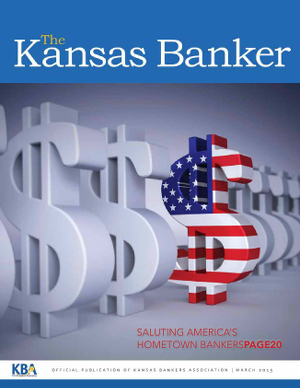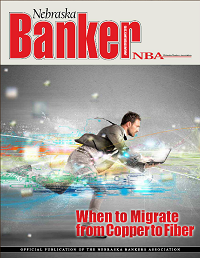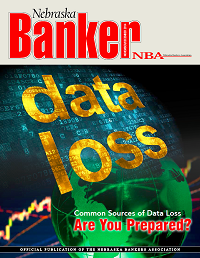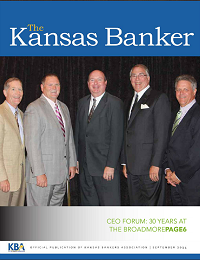Strengthening the Resilience of Outsourced Technology Services
By: Russ Horn (CISA, CISSP, CRISC)
Publication: The Kansas Banker, March 2015
 On February 6, 2015, the FFIEC issued a new appendix titled "Strengthening the Resilience of Outsourced Technology Services" to the "Business Continuity Planning" booklet of the FFIEC Information Technology Examination Handbook. This new appendix discusses the following four key elements financial institutions should address related to Technology Service Providers (TSPs).
On February 6, 2015, the FFIEC issued a new appendix titled "Strengthening the Resilience of Outsourced Technology Services" to the "Business Continuity Planning" booklet of the FFIEC Information Technology Examination Handbook. This new appendix discusses the following four key elements financial institutions should address related to Technology Service Providers (TSPs).
Third-Party Management
"Establishing a well-defined relationship with TSPs is essential to business resilience. A financial institution's third-party management program should be risk-focused and provide oversight and controls commensurate with the level of risk presented by the outsourcing arrangement."
The guidance focuses on the following third-party management components:


 Winter is coming and this year, it seems like there is a lot of uncertainty about what it will bring. It may bring tidings of good cheer, or it may bring something akin to my idea of figgy pudding. We just don't know. This is called a "blind spot."
Winter is coming and this year, it seems like there is a lot of uncertainty about what it will bring. It may bring tidings of good cheer, or it may bring something akin to my idea of figgy pudding. We just don't know. This is called a "blind spot." At this point, you've all heard of – and probably read – the FFIEC's Cybersecurity Guidance. In the FFIEC Cybersecurity Assessment General Observations, one of the items the FFIEC wants you to consider is the, "process for determining and implementing preventative, detective, and corrective controls." I must admit, at first glance, I did not see the value in classifying controls. My opinion was that a control is a control, and all are good to have. I argued that classifying controls was a waste of time. After a few discussions, however, I began to see the error of my ways. I am now on Team Classify. Why? Well, I'm glad you asked! First let's look at the differences in these controls:
At this point, you've all heard of – and probably read – the FFIEC's Cybersecurity Guidance. In the FFIEC Cybersecurity Assessment General Observations, one of the items the FFIEC wants you to consider is the, "process for determining and implementing preventative, detective, and corrective controls." I must admit, at first glance, I did not see the value in classifying controls. My opinion was that a control is a control, and all are good to have. I argued that classifying controls was a waste of time. After a few discussions, however, I began to see the error of my ways. I am now on Team Classify. Why? Well, I'm glad you asked! First let's look at the differences in these controls: We have all heard the phrases "up to snuff," "hit the mark," "cut the mustard," and "make the cut." These idioms are similar in definition, indicating some process or procedure has proven to be effective. Many organizations spend a great deal of time and effort in the development stage of their business continuity plan, but too often fail to provide an appropriate avenue for testing or validating the plan. The Responsibilities section of the FFIEC's IT Examination Handbook, Business Continuity Planning (a.k.a. FFIEC BCP Booklet) states Board and Senior Management responsibilities include, "ensuring the BCP is regularly tested on an enterprise-wide basis and reviewing the BCP testing program and test results on a regular basis."
We have all heard the phrases "up to snuff," "hit the mark," "cut the mustard," and "make the cut." These idioms are similar in definition, indicating some process or procedure has proven to be effective. Many organizations spend a great deal of time and effort in the development stage of their business continuity plan, but too often fail to provide an appropriate avenue for testing or validating the plan. The Responsibilities section of the FFIEC's IT Examination Handbook, Business Continuity Planning (a.k.a. FFIEC BCP Booklet) states Board and Senior Management responsibilities include, "ensuring the BCP is regularly tested on an enterprise-wide basis and reviewing the BCP testing program and test results on a regular basis." For some, holiday shopping is like Christmas every day. For others, it's like a never-ending Black Friday.
For some, holiday shopping is like Christmas every day. For others, it's like a never-ending Black Friday. Are you familiar with the term harvesting? User credentials can be gathered from sites with, likely, weak security. This gathering process has been named harvesting and has been a recent issue in the security world.
Are you familiar with the term harvesting? User credentials can be gathered from sites with, likely, weak security. This gathering process has been named harvesting and has been a recent issue in the security world. Fifteen years ago some of the hot topics in the information security community were the implementation of smart cards and biometrics for authentication. The purpose of these security tools (at least partially) was to replace passwords with something we don't have to remember. Over time, neither of these solutions have proven to pan out for the majority of us as methods to replace passwords. Granted, both methods saw limited implementations, but the masses likely have never used these technologies or use them in limited fashion.
Fifteen years ago some of the hot topics in the information security community were the implementation of smart cards and biometrics for authentication. The purpose of these security tools (at least partially) was to replace passwords with something we don't have to remember. Over time, neither of these solutions have proven to pan out for the majority of us as methods to replace passwords. Granted, both methods saw limited implementations, but the masses likely have never used these technologies or use them in limited fashion. Phishing attacks are a part of everyday life, and according the "Global Phishing Survey 2H2013: Trends and Domain Name Use" by Anti-Phishing Working Group (APWG), the banking industry is the primary target of these types of attacks. So, what are phishing attacks and how can we protect our banks against these attacks?
Phishing attacks are a part of everyday life, and according the "Global Phishing Survey 2H2013: Trends and Domain Name Use" by Anti-Phishing Working Group (APWG), the banking industry is the primary target of these types of attacks. So, what are phishing attacks and how can we protect our banks against these attacks? Most banks have been through multiple examination and audit cycles since the much anticipated and discussed FFIEC Supplement to Authentication in an Internet Banking Environment (the Supplement) released June 28, 2011 (
Most banks have been through multiple examination and audit cycles since the much anticipated and discussed FFIEC Supplement to Authentication in an Internet Banking Environment (the Supplement) released June 28, 2011 (